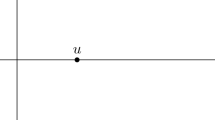Abstract
The paper studies a two-stage location-price duopoly game in a disk city with consumer concentration around the city center. When consumers are uniformly distributed over the plane, unconstrained firms locate outside of the city. Consumer concentration, however, induces firms to locate nearer to each other and, when the degree of concentration is sufficiently high, inside of the city. Prices and firm profits decrease in the degree of consumer concentration. We explicitly solve the model for classes of cone-shaped, dome-shaped, and bell-shaped consumer densities. In all cases we identify a loss of welfare due to the strategic effect which causes the firms’ spatial differentiation being too large.


Similar content being viewed by others
Notes
The disk area on the right side of the vertical line \(\tilde{x}\) is \(2\int_{\tilde{x}}^{1}r\arccos(\tilde{x}/r)dr\). Multiply at each point in this area by the local consumer density \(f(r)\) to obtain the demand function \(D(\tilde{x})\).
If the city border is binding, firms locate on the disk’s perimeter at maximal distance. Substituting \(x_{1}=-x_{2}=1\), \(D(\tilde{x}=0)=1/2\), and \(D^{\prime}(\tilde{x}=0)=-2/\pi\) into the price equations (4) shows that the firms charge the prices \(p=\pi<p^{*}\) and hence realize the profits \(\Pi=(1/2)\pi<\Pi^{*}\). This solution is the constrained optimum as it was derived by Mazalov and Sakaguchi (2003) and Feldin (2012).
This is a two-dimensional counterpart to the one-dimensional beta density function as used by Stadler (2012).
Note that \(\Gamma(1/2)=\sqrt{\pi}\), \(\Gamma(1)=1\), and \(\Gamma(n+1)=n\Gamma(n)\) for \(n=\{1/2,1\}\).
Note that the tiny area differential \(dA\) for the polar coordinates (\(r,\phi\)) is \(dA=rdrd\phi\).
Additionally, the population of the city – an alternative measure of the “city size” – does not have to be restricted to the mass of 1. An increasing mass would leave the location and price decisions of the firms unchanged but would proportionally increase their profits.
In case of finite support, a rectangular (or a quadratic) product space would certainly be preferable to a disk space. A quadratic product space, however, is not tractable for an analysis of demand concentration since the property of polar-symmetry is not satisfied. In the case of infinite support, the geometrical difference between a disk and a square diminishes such that this problem is resolved.
As pointed out e.g. by Ansari et al. (1994), the distribution of consumer preferences in many markets is unlikely to be uniform.
Note that \(\arccos(0)=\pi/2\) and \(2\pi\int_{0}^{1}rf(r)dr=1\) for all feasible polar-symmetric consumer densities.
References
Anderson, S.P., J.K. Goeree, and R. Ramer. 1997. Location, Location, Location. Journal of Economic Theory 77:102–127.
Ansari, A., N. Economides, and A. Ghosh. 1994. Competitive Positioning in Markets with Nonuniform Preferences. Marketing Science 13:248–273.
Ansari, A., N. Economides, and J. Steckel. 1998. The Max-Min-Min Principle of Product Differentiation. Journal of Regional Science 38:207–230.
Böckem, S. 1994. A Generalized Model of Horizontal Product Differentiation. Journal of Industrial Economics 17:287–298.
Brenner, S. 2005. Hotelling Games with Three, Four, and More Players. Journal of Regional Science 45:851–864.
Casado-Izaga, F.J. 2000. Location Decisions: The Role of Uncertainty about Consumer Tastes. Journal of Economics 71:31–46.
D’Aspremont, C., J.J. Gabszewicz, and J.-F. Thisse. 1979. On Hotelling’s Stability in Competition. Econometrica 47:1145–1150.
Economides, N. 1986. Minimal and Maximal Product Differentiation in Hotelling’s Duopoly. Economics Letters 21:67–71.
Feldin, A. 2012. Three Firms on a Unit Disk Market: Intermediate Product Differentiation. Economic and Business Review 14:321–345.
Hotelling, H. 1929. Stability in Competition. Economic Journal 39:41–57.
Irmen, A., and J.-F. Thisse. 1998. Competition in Multi-Characteristics Spaces: Hotelling Was Almost Right. Journal of Economic Theory 78:76–102.
Lambertini, L. 1994. Equilibrium Locations in the Unconstrained Hotelling Game. Economic Notes 24:438–446.
Mazalov, V., and M. Sakaguchi. 2003. Location Game on the Plane. International Game Theory Review 5:13–25.
Meagher, K.J., and K.G. Zauner. 2004. Product Differentiation and Location Decisions under Demand Uncertainty. Journal of Economic Theory 117:201–216.
Meagher, K.J., and K.G. Zauner. 2005. Location-then-Price Competition with Uncertain Consumer Tastes. Economic Theory 25:799–818.
Meagher, K.J., E.G.S. Teo, and W. Wang. 2008. A Duopoly Location Toolkit: Consumer Densities which Yield Unique Spatial Duopoly. Equilibria. B.E. Journal of Theoretical Economics 8:1–21.
Stadler, M. 2012. Standortwahl und Produktdifferenzierung. In Zur Zukunft des Wettbewerbs. Marburg. Metropolis Verlag, ed. H. Enke, A. Wagner, 323–338.
Tabuchi, T. 1994. Two-Stage Two-Dimensional Spatial Competition between Two Firms. Regional Science and Urban Economics 24:207–227.
Tabuchi, T. 2012. Multiproduct Firms in Hotelling’s Spatial Competition. Journal of Economics and Management Strategy 21:445–467.
Tabuchi, T., and J.-F. Thisse. 1995. Asymmetric Equilibria in Spatial Competition. International Journal of Industrial Organization 13:213–227.
Veendorp, E.C.H., and A. Majeed. 1995. Differentiation in a Two-Dimensional Market. Regional Science and Urban Economics 25:75–83.
Woeckener, B. 2002. Spatial Competition with an Outside Good and Distributed Reservation Prices. Journal of Economics 71:31–46.
Author information
Authors and Affiliations
Corresponding author
Additional information
Paper presented at the 18th annual GEABA conference at the University of Hohenheim. The author gratefully acknowledges comments of the participants, especially of the discussant Karl Morasch, as well as the helpful suggestions of two anonymous referees.
Appendix
Appendix
As described in the main text, the demand function of firm 1 reads
and the demand of firm 2 is \(1-D(\tilde{x})\). By using Leibniz’s rule and integrating by parts, we obtain the derivatives
and
In the case of \(\tilde{x}=0\) (symmetric firm location around the city center), one obtainsFootnote 10
The first two derivatives amount to
and
Rights and permissions
About this article
Cite this article
Stadler, M. Location in a Disk City with Consumer Concentration Around the Center. Schmalenbach Bus Rev 71, 35–50 (2019). https://doi.org/10.1007/s41464-018-0064-0
Received:
Accepted:
Published:
Issue Date:
DOI: https://doi.org/10.1007/s41464-018-0064-0




